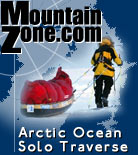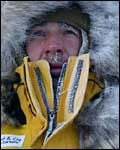

The Arktos Expedition
Mike Horn Attempts First Solo, Unsupported Traverse of the Arctic
Cape Artichevsky, Siberia
 | |
| Mike Horn © Sebastian Devenish | |
While Horn's prior polar experience is negligible, he has already proven his expedition credentials by circumnavigating the equator in an expedition called 'Latitude 0' two years ago. This latest expedition, dubbed 'Arktos', will be a little chillier and with even less margin for error.
"Horn could not afford to wait till the days were any longer as each would extend the journey on the other side; the summer days would see the Arctic ice melting and reducing in area from 16,000 square kilometers to only 9,000..." |
In 2000, two expeditions made the polar record books. Norwegians Rune Gjeldnes and Torry Larsen became the first to cross the Arctic Ocean, from Siberia, via the geographic North Pole, to Canada's Northwest Territories without aid. Then last year, fellow Norwegian Borge Ousland set off on a solo and unsupported trek, but when his sled broke early into the expedition, and he had to have a new one flown in, his journey lost its "unsupported" classification. (See National Geographic, March 2002.)
The problem with crossing unsupported is mainly one of weight. Horn's kevlar sled is loaded with 200kg of equipment, of which 110kg is food, and 26kg the fuel to heat it, the amount required for the four-month, 4,000km journey in which his body will need a phenomenal amount of kilojoules per day to replace that lost through the arduous task of pulling a sled across the frozen ice landscape that is far from flat, shaped as it is by drift- and wind-moulded ice.
On the 27th of February, Horn was dropped by helicopter near Cape Artichevsky on Siberia's Taymyr Peninsula, the world's most northerly continental land, stretching 1,200km north of the Arctic Circle. The timing was crucial.
The sun had made its first appearance of the season only two weeks before, but Horn could not afford to wait till the days were any longer as each would extend the journey on the other side; the summer days would see the Arctic ice melting and reducing in area from 16,000 square kilometers to only 9,000. Melted ice would make the second part of his traverse, the journey from the pole to Canada, that much more difficult.
Three other expeditions left soon after: two Australian pairs and a Chinese solo, but all were journeying only to the Pole, from where they would be picked up by helicopter, so they had a little more time.
— Dominique le Roux, MountainZone.com Correspondent
|
|